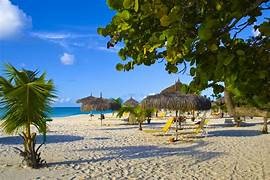
Aruba, a tiny Dutch Caribbean island off the coast of Venezuela, is a paradise that boasts of natural beauty beyond imagination. Known for its stunning white-sand beaches, crystal-clear turquoise waters, and a year-round warm climate, Aruba is a dream destination for many travelers worldwide.
The island’s natural beauty is not limited to its breathtaking beaches. Aruba is also home to a diverse range of flora and fauna, some of which are unique to the island. The Arikok National Park, which covers nearly 20% of the island, is a treasure trove of natural wonders. Here, you can explore the rugged landscapes, discover hidden caves, and encounter various species of wildlife, including the Aruban burrowing owl and the Aruban whiptail lizard.
Aruba’s underwater world is equally captivating. The island’s coral reefs are teeming with marine life, offering an unforgettable snorkeling and diving experience. The Antilla shipwreck, one of the largest shipwrecks in the Caribbean, is a popular dive site where you can explore the remains of a German cargo ship that sank during World War II.
The island’s natural beauty extends to its people and culture. Arubans are known for their warm hospitality and vibrant culture, which is a blend of indigenous, African, and European influences. The island’s rich history is reflected in its architecture, cuisine, music, and festivals.
Now, you might be wondering when is the best time to visit this Caribbean paradise. The good news is that Aruba has a consistently warm climate throughout the year, with average temperatures ranging from 80 to 90 degrees Fahrenheit. This makes it a perfect destination for a beach vacation at any time of the year.
However, if you want to avoid the crowds and enjoy the island at a more leisurely pace, the best time to visit Aruba is during the off-peak season, which runs from April to August. During this period, the island is less crowded, and you can often find great deals on accommodations and flights.
If you’re a nature lover, the best time to visit Aruba is during the rainy season, which runs from October to January. Although the island receives only a moderate amount of rainfall, the rain brings a burst of greenery, making the landscapes even more beautiful.
For those who are interested in experiencing the island’s vibrant culture, the best time to visit Aruba is during the Carnival season, which runs from January to March. During this period, the island comes alive with colorful parades, music, and dance, offering a unique cultural experience.
In conclusion, Aruba is a paradise that offers a wealth of natural beauty and a warm, vibrant culture. Whether you’re a beach lover, a nature enthusiast, or a culture buff, there’s something for everyone on this beautiful Caribbean island. And with its year-round warm climate, you can visit Aruba at any time of the year. So why wait? Start planning your trip to this Caribbean paradise today!
Aruba, a gem in the Caribbean, is renowned for its stunning natural beauty. This island paradise, with its pristine beaches, crystal clear waters, and vibrant coral reefs, is a dream destination for many travelers. However, to fully appreciate the splendor of Aruba, it’s essential to plan your visit during the best times of the year.
Aruba’s climate is tropical but not extreme, with a fairly constant temperature around the year. However, the island does have a high and low season, which can significantly impact your experience. The high season, which runs from mid-December to mid-April, is when the island experiences its best weather. During this period, the island is at its most vibrant, with a plethora of activities and events for visitors to enjoy. The weather is warm and dry, with temperatures averaging around 82 degrees Fahrenheit. This is the perfect time for sunbathing on the beach, exploring the island’s natural parks, or diving into its clear waters to explore the coral reefs.
However, the high season also means high prices and large crowds. Accommodation rates can be significantly higher, and popular attractions can be crowded. If you’re looking for a more relaxed, intimate experience, you might want to consider visiting during the low season.
The low season in Aruba runs from mid-April to mid-December. During this period, the island is less crowded, and prices for accommodation and activities are generally lower. The weather is slightly more humid, with occasional rain showers, but these are usually brief and followed by sunshine. The temperatures remain warm, averaging around 88 degrees Fahrenheit, making it still a great time for beach activities and water sports.
One of the advantages of visiting Aruba during the low season is the opportunity to experience the island’s natural beauty without the crowds. You can take leisurely walks on the beach, enjoy the tranquility of the natural parks, or snorkel in the coral reefs at your own pace. Additionally, the lower prices mean you can enjoy a longer stay or indulge in activities that might be beyond your budget during the high season.
However, it’s worth noting that some businesses, particularly those in the tourism industry, may close or have reduced hours during the low season. It’s always a good idea to check in advance to ensure that the attractions and activities you’re interested in will be available.
In conclusion, the best time to visit Aruba depends on what you’re looking for in your Caribbean vacation. If you want the best weather and don’t mind the crowds and higher prices, the high season is the best time to visit. On the other hand, if you prefer a more relaxed pace, fewer crowds, and lower prices, the low season might be more to your liking. Regardless of when you choose to visit, Aruba’s natural beauty is sure to leave you spellbound.
Aruba, a tiny Dutch Caribbean island off the coast of Venezuela, is a paradise that boasts an enchanting blend of natural beauty and cultural richness. Known for its pristine beaches, crystal clear waters, and vibrant coral reefs, Aruba is a haven for nature lovers and adventure seekers alike. But the island’s allure extends beyond its stunning coastline. From its rugged landscapes to its unique wildlife, Aruba offers a diverse range of natural attractions that are sure to captivate any visitor.
One of the most striking features of Aruba is its diverse landscape. The western and southern coasts of the island are known for their white sandy beaches and calm, turquoise waters, making them perfect for swimming, snorkeling, and sunbathing. On the other hand, the eastern and northern coasts are characterized by their rugged terrain, with rolling hills, rocky cliffs, and wild waves. This contrast in landscapes offers a unique opportunity for visitors to experience both the serene and the wild side of Aruba.
In addition to its beautiful beaches and rugged landscapes, Aruba is also home to a variety of unique wildlife. The island is particularly known for its population of colorful and exotic birds, including the Aruban burrowing owl, the Caribbean parakeet, and the troupial. These birds, along with a host of other species, can be spotted in the island’s national parks and nature reserves, making bird watching a popular activity among visitors.
Aruba’s natural beauty is further enhanced by its vibrant coral reefs. These underwater ecosystems are teeming with life, hosting a variety of marine species including colorful fish, sea turtles, and even sharks. Snorkeling and diving are popular activities in Aruba, offering visitors a chance to explore these stunning underwater landscapes.
While Aruba’s natural beauty is undoubtedly its main attraction, the island also offers a rich cultural experience. The influence of the island’s Dutch heritage can be seen in its architecture, food, and festivals. Moreover, the locals, known as Arubans, are known for their warm hospitality, making visitors feel welcome and at home.
So, when is the best time to visit this Caribbean paradise? Aruba enjoys a warm tropical climate year-round, with average temperatures hovering around 28°C (82°F). However, the best time to visit is generally considered to be from April to August. During these months, the island experiences less rainfall and the weather is typically sunny and dry, making it ideal for outdoor activities. Moreover, this period falls outside of the Caribbean’s hurricane season, ensuring a safer and more enjoyable trip.
However, it’s worth noting that these months also coincide with the island’s peak tourist season. Therefore, if you prefer a quieter and less crowded experience, you might want to consider visiting during the off-peak season, which runs from September to November.
In conclusion, Aruba is a Caribbean gem that offers a unique blend of natural beauty and cultural richness. Whether you’re a nature lover, an adventure seeker, or a culture enthusiast, Aruba has something to offer you. So why wait? Start planning your trip to this Caribbean paradise today!
First on our list is Papiamento, a family-owned restaurant set in a 126-year-old Aruban manor. The restaurant offers a unique dining experience, with its antique Dutch furniture and tropical garden setting. Papiamento’s menu features a mix of Aruban, Dutch, and international dishes, with the Keshi Yena, a traditional Aruban dish made of stuffed cheese, being a standout.
Next is the Flying Fishbone, a restaurant that takes seaside dining to a whole new level. Located in the fishing village of Savaneta, diners can enjoy their meal with their feet in the sand or even in the water at high tide. The restaurant specializes in seafood dishes, with the Caribbean Lobster Tail and the Red Snapper being crowd favorites.
For those who prefer a more casual dining experience, Zeerovers is a must-visit. This local seafood joint offers a simple menu of fresh fish and shrimp, served with a side of plantains and pan bati, a traditional Aruban bread. The laid-back atmosphere and stunning ocean views make Zeerovers a favorite among locals and tourists alike.
Meanwhile, El Faro Blanco, located at the California Lighthouse, offers breathtaking views of the island’s western coastline. The restaurant serves a variety of Italian dishes, with the homemade pasta and risotto being highly recommended.
For a taste of authentic Dutch cuisine, head to Linda’s Dutch Pancakes. This cozy restaurant is famous for its Dutch pancakes, which come in a variety of sweet and savory options. The apple cinnamon pancake and the bacon and cheese pancake are among the must-try dishes.
Another restaurant that offers a unique dining experience is Atardi. Located on the beachfront of the Marriott Stellaris Resort, Atardi specializes in seafood dishes. The restaurant’s romantic setting, with its stunning sunset views, makes it a popular choice for couples.
For those who love steak, the West Deck Island Grill is a must-visit. This beachside restaurant offers a variety of grilled dishes, with the Angus Beef Tenderloin and the Baby Back Ribs being crowd favorites.
